Chapter 2
Lasers in Science and Industry
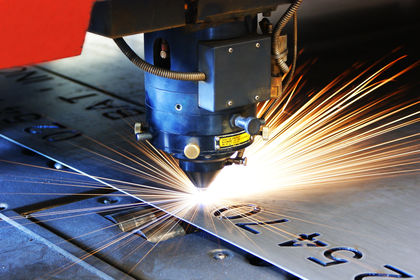
Today scientists, lab technicians, engineers, and industrial technicians regularly utilize lasers to perform a wide range of important tasks. They measure distances, both short and long, with lasers, giving astronomers, geographers, and surveyors much more accurate figures than were available before the invention of these devices. They also use lasers to drill, weld, cut, and mark all sorts of materials; to study microscopic objects, including molecules; and even to fight crime.
Astronomy, Geography, and Surveying
One of the most important scientific uses for lasers is that of an advanced measuring tool. The potential of these devices to give precise figures for very long distances was shown in 1969 when the Apollo 11 astronauts became the first men ever to walk on the moon. Before blasting off on their return flight they left behind a bizarre-looking mirror. A short time later scientists on Earth claimed that the strange mirror had revealed to them the distance from Earth to the moon, a figure that was accurate to within the length of a person's finger. This moon mirror was neither mysterious nor magical, though it would have seemed so to many people only a few years before. In reality, National Aeronautics and Space Administration (NASA) scientists had instructed the astronauts on exactly how to position the mirror as part of a plan to measure the Earth-to-moon distance with a laser beam.
Before lasers existed, scientists already had a fairly good idea of how far away the moon is. But "fairly good" is not good enough in science. Scientists want their measurements to be as exact as possible, and bouncing a laser beam off the mirror promised to give
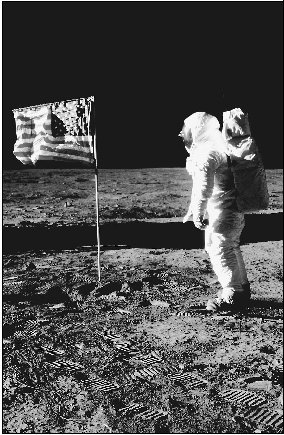
Measuring distance by means of lasers and mirrors works just as well on Earth as it does in space. Every day, surveyors use lasers to measure the distances between houses, roads, and mountains. A device called a range finder utilizes the same principle as the moon mirror; a surveyor aims a laser beam at a reflective target and the beam bounces back to the range finder, which records the time of the round-trip and uses this figure to calculate the exact distance to the target. This method is more accurate and also much faster than older surveying methods, which required many calculations with poles and telescopes that had to be lined up with one another. Erecting skyscrapers, excavating tunnels and canals, laying pipelines, drilling wells, leveling farmland (making it flatter and easier to exploit) are only a few of the many other projects made easier by precise laser measurements. Such measurements also have led to more exact and reliable maps; using lasers, mapmakers have now charted almost every square mile of Earth's surface.
Laser Toolbox Technology
Such precise measurement is just one of several jobs that, before the advent of lasers, were associated with what engineers and others call "toolbox" technology. Every toolbox has its yardstick, ruler, or tape measure. It also has a drill to bore holes and a hacksaw to cut metal. Larger toolboxes include welding equipment to join pieces of metal together. Just as lasers have come to replace the yardstick in measuring, they also have replaced the drill, the saw, and the welder. The era of the toolbox laser has arrived.
Measuring Distances with Lasers
Lasers can measure enormous distances with great accuracy. A laser beam travels at a constant speed (the speed of light). The time it takes a laser beam to travel from its source, reflect off an object, and return to the source, will indicate the exact distance between the source and the object.
Lasers perform some toolbox jobs better and faster because of some unusual properties of laser light itself. In the first place, laser light is extremely bright, so bright that laser operators always wear protective glasses. The light is so intense because its energy is very concentrated; there are a great number of photons in a relatively small beam.
Properties of Laser Light
The photons of laser light are collimated. In other words, they all travel from the laser in the same direction. Laser light is also coherent, meaning that all the waves in a laser beam have the same wave pattern. These properties make laser light more intense than ordinary light and allow it to travel long distances. Ordinary light waves scatter in all directions from their source. Also, an ordinary beam of light is incoherent, meaning that it contains waves of many different patterns, which tend to interfere with one another.
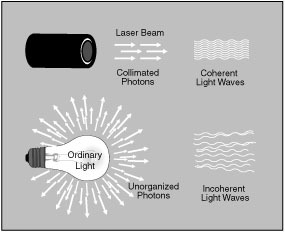
Laser light is also highly directional, or collimated. This means that all the photons travel in the same direction. They tend to stay together rather than spread apart as the photons in ordinary light do. The farther a beam of ordinary light travels, the more it spreads out and gets dimmer. On the other hand, collimated laser light can travel a great distance without losing very much of its energy and brightness. Ordinary light could never have made it to the moon mirror and back, whereas laser light did quite easily.
There is one more important quality of laser light. It is coherent, or very organized. This means that the light waves are lined up with each other and moving along in step, almost like a regiment of soldiers marching in a parade. By contrast, ordinary light is incoherent. Its waves become mixed up as they move along, like the crowd of people watching the parade. So, the laser light is special. It is concentrated, directional, and organized.
These three qualities combine to make the laser an extremely powerful and useful tool in materials processing, the industrial manipulation of metals, plastics, wood, ceramics, cloth, and other materials for making a wide range of products. Breck Hitz, an expert on industrial lasers, elaborates:
Lasers are used to cut, drill, weld, heat-treat, and otherwise alter both metals and nonmetals. Lasers can drill tiny holes in turbine blades more quickly and less expensively than mechanical drills. Lasers have several advantages over conventional techniques of cutting materials. For one thing, unlike saw blades or knife blades, lasers never get dull. For another, lasers make cuts with better edge quality than most mechanical cutters. The edges of metal parts cut by a laser rarely need to be filed or polished because the laser makes such a clean cut. 1
Drilling and Burning Holes with Light
A laser beam excels as an industrial drill because it can be focused into a tiny bright point. Of course, ordinary light can be focused in a similar way. For instance, a magnifying glass held up to the sun will focus the sun's rays into a tiny, very bright point, a point that is also hot enough to burn a leaf or ignite a piece of paper.
Now consider collimated laser light, which is hundreds of times more directional than ordinary light. It can be focused to produce a beam of light, much hotter than the surface of the sun, that can cut cleanly through a thick metal bar in a few millionths of a second.
One of the more important uses of the laser drill in industry is in the production of copper wire. The wire is formed by forcing copper metal into a small round hole that a laser has drilled into a diamond. The hard diamond acts like a mold, and the much softer copper squeezes out the other end in the form of wire. The old method of drilling holes in industrial diamonds was very time-consuming and expensive. Since the only naturally occurring material hard enough to cut through a diamond is another diamond, workers had to use diamond drills. But diamonds are expensive. Furthermore, the drilling process took several hours, so a worker could drill only two or three holes in a workday. In contrast, a laser beam drills holes in diamonds at the speed of light. One worker using one laser can bore hundreds or even thousands of holes in a single hour. And the same method is used for drilling holes in other gems that are used as moving parts in watches.
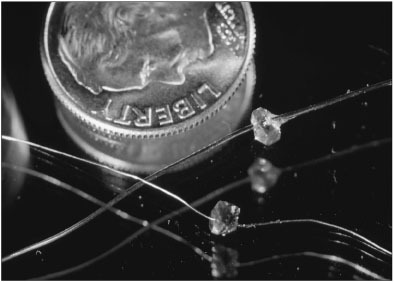
Though it might seem surprising, lasers are also effective in boring holes in very soft materials. Some of these materials are easily stretched or torn by ordinary methods. An excellent example is the common baby bottle nipple. A laser beam burns a perfectly round hole in the top of the nipple without disturbing any of the surrounding rubber. Similarly, lasers are used to drill tiny holes in the soft plastic valves of spray cans (such as those of hair spray or glass cleaner). One such laser can punch over a thousand valve holes in one minute.
Welding and Cutting with Lasers
Another industrial application of lasers is welding. The advantage of the laser over normal welding methods is similar to its advantage in other industrial areas. The laser is hotter, faster, more accurate, and also safer because the welder does not have to go near the hot metal.
Laser welding works on both large and small scales. On the large scale, the U.S. Navy uses lasers to weld together huge metal parts in shipbuilding. Experts estimate that millions of dollars are saved in the welding process and millions more in reduced need for later repairs. Such common items as automobile spark plugs, portable batteries, and metal braces for the teeth are also routinely welded by laser beams.
On a smaller scale, lasers weld the parts for tiny electrical circuits used in computers, calculators, and miniature television sets. In the past, welding these small parts was accomplished by soldering—melting a metallic substance called solder around them to ensure a proper electrical connection. But soldering tools cannot be made small enough to weld the very tiny electrical parts now being produced; and manipulating the smallest available soldering tools is very painstaking work, produces uneven results, and can damage the delicate parts. By contrast, such tiny welds, some of them even microscopic, are easily made by the hot, razor-thin beam of a carbon dioxide laser.
In industry the opposite of welding is cutting, another essential process for making all manner of products.
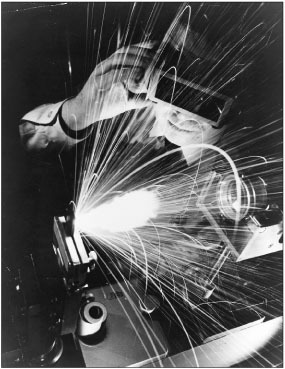
An example of the use of "laser scissors" is to cut patterns for clothes. A laser cloth-cutting system was designed by Hughes Aircraft, the company that employed Theodore Maiman, the inventor of the ruby laser. The system works in the following way: Pieces of cloth are laid out on a large table while the patterns are entered into a computer, which decides the best way to trace them out on the cloth. Next, the computer directs the laser beam to cut out the traced patterns very precisely. Cloth for hundreds of suits can be cut in an hour, and as an added advantage the heat of the beam keeps the edges of the cloth from fraying.
Such laser scissors can be made to work on a microscopic level as well, not only in industry but also in biological research. Scientists who study and attempt to manipulate plant or animal cells can use a laser beam to make tiny alterations—in a sense performing microsurgery—on such cells. Recent experiments show that the use of lasers also can eliminate a serious obstacle to such microscopic manipulation; namely, the difficulty of holding a cell in place while working on it. To accomplish this task laser scissors are often accompanied by "laser tweezers," as explained by University of California scholar Michael Berns:
That light can heat or burn, measure or calibrate makes sense. But the idea of light creating a force that can hold and move an object may seem as fanciful as a Star Trek tractor beam. Still, light has momentum [a forward-pushing force] that can be imparted to a target. The resultant [very small] forces fall far below our sensory awareness when, for example, the sun's light falls on and imperceptibly pushes against us. But these forces can be large enough to influence biological processes at the subcellular level, where the masses of the objects are [extremely tiny]. . . . When the geometry of the arrangement of light beams and target is correct, the momentum imparted to the target pulls the target in the direction of the . . . laser beam, and the beam can thus hold the target in place. By moving the beam, the laser operator can pull the target from place to place. 2
Fighting Crime with Lasers
The toolbox laser can even be used, along with other scientific tools such as DNA testing, to fight crime. A laser beam can scan a computerized record of millions of criminals' fingerprints, for instance, and in a few seconds pick out one that matches a print found at a crime scene. Laser beams can also detect extremely minute and very old traces of perspiration and other human body secretions. In the 1990s the FBI investigated a man they believed to be a former German Nazi in World War II. He denied the charge. But then the FBI obtained a postcard written by the Nazi in 1942, and a laser was able to find traces of body oils on the card; the oils were identical to those of the suspect, who was found guilty and imprisoned.
In another example of lasers acting as detectives, some people are recovering stolen gems thanks to a system called laser identification. An ID marking is carved into the gem by a laser that creates a thin and accurate beam. This beam, which is so tiny it can cleanly drill more than two hundred holes in the head of a pin, carves or etches microscopic numbers, words, people's names and addresses, or entire messages on any material, no matter how smooth or hard. This includes precious gems like emeralds and diamonds. The result is an ID marking so tiny that no one, including a thief, can detect it with the naked eye. Many other valuable items are now marked in this manner by laser beams.
Almost every day several new uses are found for toolbox lasers. The devices are still rather expensive, so
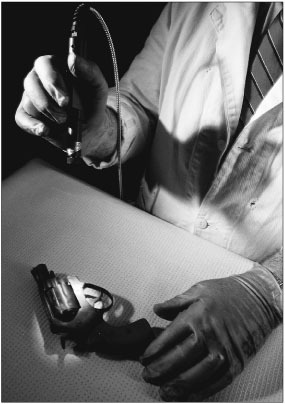
great article,,,useful for projects and assignments too
Am I thinking wrong about this?